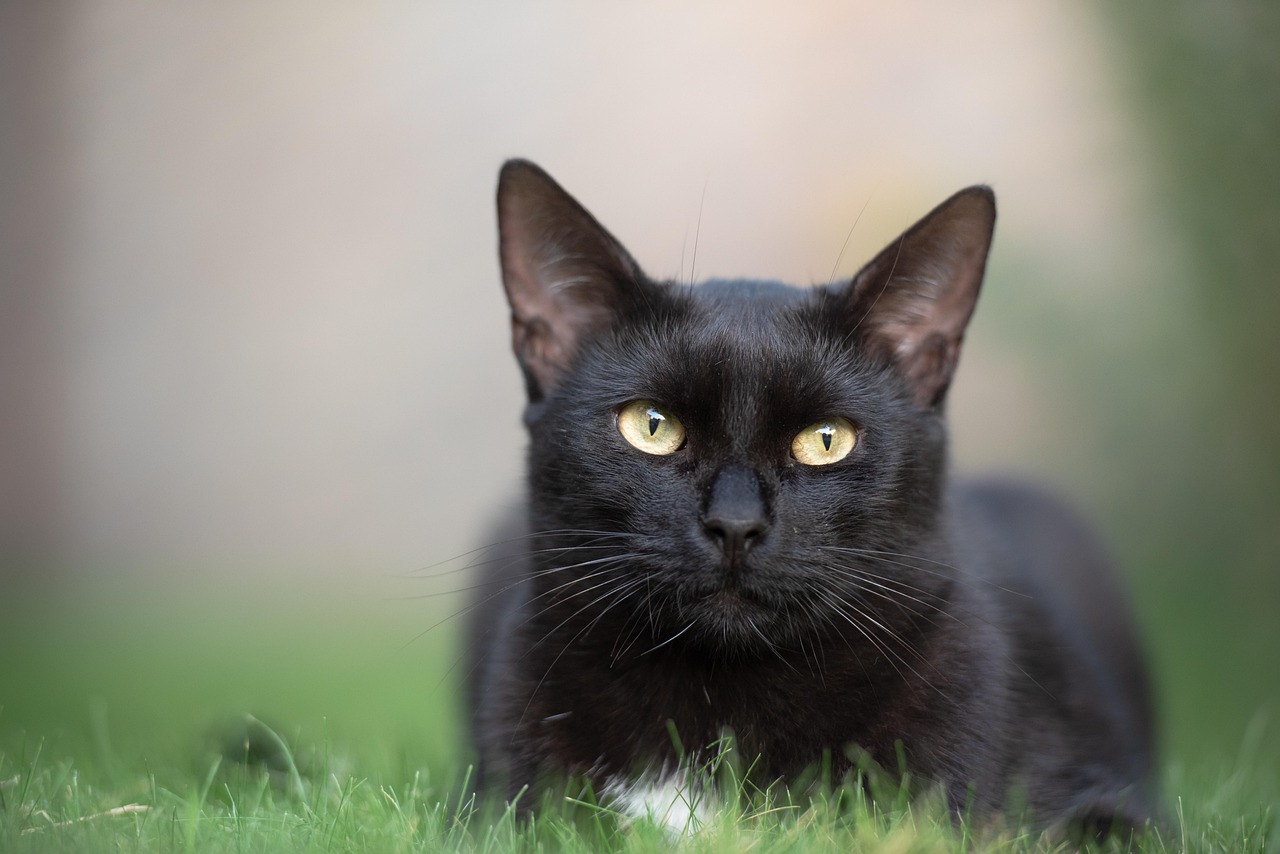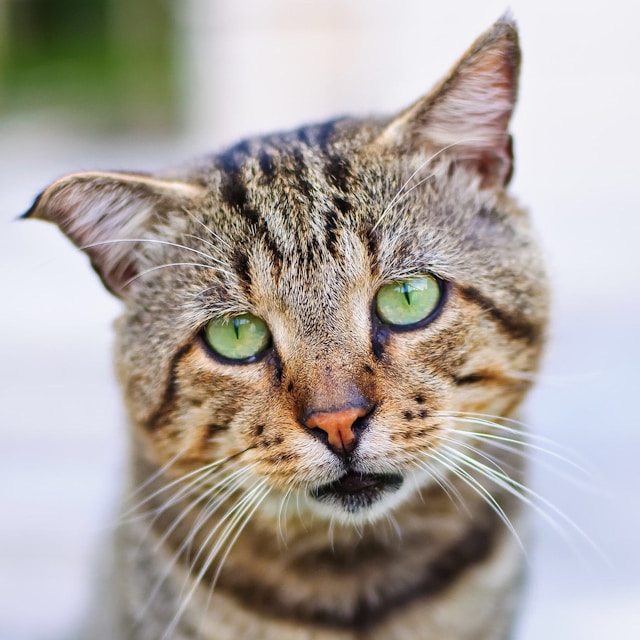Bombay

| OFFICIAL NAME | Bombay |
| COMMON NAME | Bombay |
| PET HEIGHT | 9 to 13 inches |
| PET WEIGHT | 8 to 15 pounds |
| LIFESPAN | 9 to 15 years |
| GOOD WITH | cats, children, families, seniors |
| TEMPERAMENT | affectionate, sociable |
| INTELLIGENCE | high |
| SHEDDING AMOUNT | seasonal |
| PLAYFULNESS | high |
| ENERGY LEVEL | active |
| VOCAL LEVEL | when necessary |
| COAT LENGTH | short |
| COLORS | black/ebony |
| PATTERNS | solid |
| OTHER TRAITS |
easy to groom, easy to train, friendly toward humans, friendly toward other pets, friendly toward strangers, good lap cat, high potential for weight gain, tolerates being picked up |
This crossed species produces a fully domesticated cat with the appearance of an elegant jungle cat.
The Bombay combines the best traits of its parent breeds. It is less talkative than the Burmese but has the same robust health, loyalty, and intelligence. It also has a gorgeous, solid black coat.
Bombay Appearance
Bombay cats look like tiny panthers curled up in your living room. Their most remarkable characteristic is their short, sleek, solid black coat with a glossy finish. A healthy Bombay coat has a shiny appearance that many breeders liken to patent leather.
The Bombay shares physical characteristics with the Burmese, although it is longer and less stocky. It has a round head, short ears with round tips, and medium-sized, round eyes that can be copper or gold in color. It is well-muscled.
A Bombay cat's characteristic swinging walk emphasizes how much it appears to be a black panther when it walks.
Bombay Personality
Combining the playful nature of a dog, the curiosity of a monkey, and the independence of a cat, the Bombay cat can be quite the handful. They can even be trained to walk on a leash and enjoy playing fetch and having fun on their own. These friendly, intelligent, and loving cats blend well with busy homes and get along well with kids. Bombays are excellent for apartment living because, despite their strong and athletic build, they are laid back and love curling up in your lap. They ought to be kept indoor cats, however.
Being heat-seekers, Bombays frequently hide under covers in all weather conditions. They use their voices to communicate and express their opinions, even though they are not the most vocal breed. These cats enjoy being the center of attention. They can get along with other dogs and cats, but it's ideal if they have lots of room to shine without having too many rivals. If they feel overshadowed, they can feel depressed or alone. To satisfy them, make sure your Bombay is the show's star.
Bombay Living Needs
Bombay cats will enjoy having a multi-level scratching post or climbing tower because they are strong, agile climbers and jumpers. These naturally energetic cats love various toys, particularly interactive ones. Bombays enjoy playing and participating in activities with their human friends.
Bombays have a strong appetite and could be at risk for obesity. Rather than leaving food out all day, feeding your cat specific amounts at predetermined times is preferable to avoid this. They eat only the best commercial diets and choose foods high in protein to support their energy requirements and muscular build.
Bombay Care
The sleek, short coat of the Bombay requires little care and almost looks after itself. Although they shed more during the regular shedding seasons, you can usually keep most of their fur off your clothes and furniture with a weekly brushing.
Since Bombay is prone to gingivitis, brushing their teeth a few times a week is advisable. If that isn't feasible, at least give out treats that prevent tartar regularly. At some point, a dental examination might also be required.
Like all cats, Bombays require regular nail trims and a clean litter box every few weeks.
Bombay Health
Bombays are generally a healthy breed with few severe genetic health problems because of their Burmese lineage. However, they may be more susceptible to asthma and sinus issues, which could be brought on by allergies or inadequate facial drainage. It is advisable to monitor their teeth and gums.
If Bombay does not control their food intake, they can become obese, especially as they age. Many veterinarians advise feeding them specific meals instead of always leaving food out to avoid this.
A Bombay cat's lifespan is typically around 15 years, but many can reach 20 years with proper care.
Bombay Exercise Requirements
Bombay cats are more active than many other domestic breeds and often love games like fetch. Due to their social nature, they can become lonely and depressed if left alone for an extended period. Make sure you have time to play with your Bombay for a few hours daily. Use a motorized cat toy or scratching post to amuse your cat while you're at work.
Bombay Training
Bombay cats usually behave well at home, though they can sometimes be bossy and dominant. Because they don't get angry quickly, behavior training is simple with them. Due to their natural curiosity, your Bombay may be exposed to external threats such as diseases and predators, so it's best to keep them indoors. Furthermore, being away from home can make them unhappy.
It is also possible to train these cats to walk on leashes. If you take Bombay for a walk or supervised outdoor time, they will love the fresh air and quality time with you.
Bombay History
Nikki Horner, a breeder from Louisville, Kentucky, developed the Bombay cat. Her goal was to create a breed resembling the Indian black leopard. To accomplish this, she crossed black American Shorthairs with Burmese cats, aiming for the muscular physique of the Burmese and the sleek, jet-black coat of the Shorthair. She also chose short hair and golden eyes to complete the look. Her foundation litter of black-haired, golden-eyed kittens, which would later become the Bombay breed, was successfully produced in 1965.
The breed was named to honor Bombay, India, to convey visions of black panthers. Although American Shorthairs and Burmese are permitted as outcrossing partners, Bombay has developed into its breed. The Cat Fanciers' Association (CFA) acknowledged it in 1970, and the International Cat Association (TICA) did the same in 1979.
Bombay Fun Facts
Particular kittens born to Bombay are pure white, despite the breed's preference for jet-black coats. During the first year, their fur gradually becomes darker.
There's more to a Bombay than just its striking black coat. Its whiskers, noses, eyelashes, and foot pads are also inky black, adding to its elegant appearance.
Get insurance plans with wide-ranging coverage options













